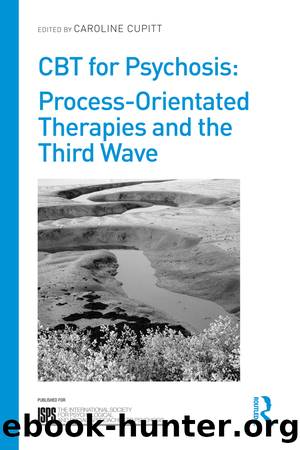CBT for Psychosis by Cupitt Caroline;

Author:Cupitt, Caroline;
Language: eng
Format: epub
Publisher: Taylor & Francis Group
Understanding Ben’s problems using the ACT model
ACT provides ways of conceptualising how Ben may be entangled with his experiences.
Ben responds to his voices in ways suggesting cognitive fusion: responding to the voices from a position of subjugation and acting on the belief he is being punished. Ben also engages in various choices and actions that serve the purpose of experiential avoidance: he does things to limit contact with voices and other experiences, such as isolating himself, switching off the radio and acting on lesser commands to appease the voices.
A further thing that contributes to the struggle for Ben is his limited contact with the present moment. His attention is dominated by scanning for threats (in the form of voice commands), by rumination and by worry about the future (which he assumes will be negative: another threatening experience). Ben’s connection with chosen life directions (values) is limited by how he responds to the voices. His actions are dominated by efforts to avoid triggering the voices and their effects on his life.
This example provides a useful way of understanding how psychological inflexibility may play a role in the maintenance of Ben’s distress and entanglement with his experiences. The ACT model considers that some responses to unusual experiences can be unworkable: that is, they reduce the opportunity for the person to engage in actions based on chosen life directions (values). This personal cost is explored with the client by looking at the short- and long-term effects of specific ways of coping, and what valued actions are possible. The ACT therapist would engage with Ben by carefully validating and understanding his efforts to cope, and also help him develop a new relationship with the voices through connecting with values, practising mindfulness and active acceptance (letting go of struggling with what cannot be controlled and being open to experiences from an observing perspective). I will use Ben’s example later in the chapter to illustrate how the ACT may be done in practice.
Download
This site does not store any files on its server. We only index and link to content provided by other sites. Please contact the content providers to delete copyright contents if any and email us, we'll remove relevant links or contents immediately.
Should I Stay or Should I Go? by Ramani Durvasula(6785)
Why We Sleep: Unlocking the Power of Sleep and Dreams by Matthew Walker(5642)
Fear by Osho(4085)
Flow by Mihaly Csikszentmihalyi(4052)
Rising Strong by Brene Brown(3781)
Why We Sleep by Matthew Walker(3773)
Too Much and Not the Mood by Durga Chew-Bose(3694)
How to Change Your Mind by Michael Pollan(3679)
The Hacking of the American Mind by Robert H. Lustig(3580)
Lost Connections by Johann Hari(3455)
He's Just Not That Into You by Greg Behrendt & Liz Tuccillo(3303)
Evolve Your Brain by Joe Dispenza(3051)
What If This Were Enough? by Heather Havrilesky(2945)
Resisting Happiness by Matthew Kelly(2887)
Crazy Is My Superpower by A.J. Mendez Brooks(2860)
The Courage to Be Disliked by Ichiro Kishimi & Fumitake Koga(2797)
The Book of Human Emotions by Tiffany Watt Smith(2771)
Descartes' Error by Antonio Damasio(2731)
In Cold Blood by Truman Capote(2685)
